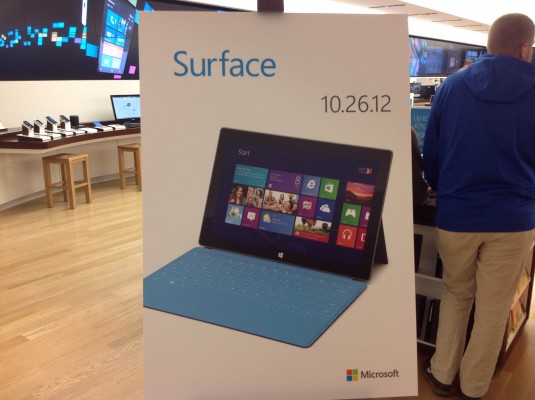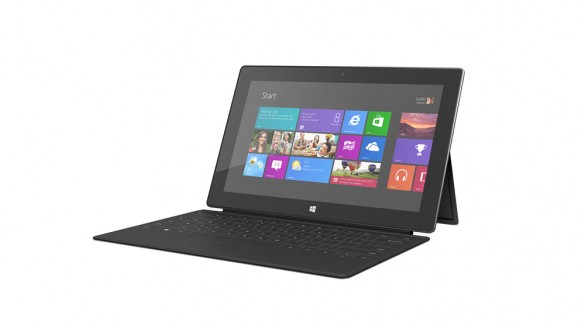
The image above is smartphone photography in its truest form; taken this month at the official Microsoft Store at the Mall of America (across the walkway from the Apple Store), this sign heralds the next big step for the software/hardware giant. Indeed, the Surface tablet by Microsoft is arriving in stores this Friday, October 26th, 2012.
And if one is asking what the heck is the Surface and why should one be interested, let me elaborate:
The Surface Tablet by Microsoft

The Surface tablet is Microsoft’s new investment into the touch screen tablet market. It comes as a 2lb, 10.6″ 10 point multi-touch HD tablet (larger in both regards than the 1.5lb, 9.7″ screened iPad) with stereo speakers, a few USB ports, a micro SD slot, front and rear facing cameras, a headphone port, and a video display output port. The tablet is supported by a 22 degree “kickstand” that can flip in and out for maximum viewability.

The main keyboard is a pressure sensitive interface that doubles as the protective case for the Surface’s screen, and for an improved typing experience can be upgraded to the hard, mechanical Type Cover. Both keyboards work in hand with the kickstand to efficiently turn on and off the Surface when closed or transported.
The Surface Operating System
Besides the physical attributes, the Surface is being advertised as two different tablets with two distinct operating system options.
Windows RT
The Surface’s first operating system coming out on October 26th is known as Windows RT, which can be considered like a “light” version of Windows 8. All the iconic Windows Metro tiles are present here (Mail, Sky Drive, Calendar, Facebook, etc); with them installed the homescreen can be modified and tweaked to suit one’s preferences. Additional applications and tiles can be downloaded by the Windows Store, which also act as the content manager for the Surface. Windows Defender is also included as a safeguard for one’ personal data.
The RT version also comes initially with Microsoft Office RT Preview, which carries all the common Office products in a non-polished form (with improvements coming through a free upgrade later on). And yes, all Office programs in the Windows RT system will be touch-friendly.
Windows 8 Pro
Although the Surface is being released with Windows RT, it is Windows 8 that will use it’s functionality to the fullest. The forthcoming Windows 8 on the Surface acts like Windows 7 in the background, but still has all those pretty Metro tiles on the front end with similar connectivity to social media and the like.
Unlike the Windows RT version, the full Office suite will be available for the Windows 8 Pro Surface, again with emphasis added on the touch capabilities for maximum efficiency. And because Windows 7 is essentially running in the background in Windows 8, the future Surface tablet will be able to run and install any application that have been compatible with existing Windows systems. Networking and security will also be expanded beyond Windows Defender with bit-locker disk encryption, remote desktop access, and other IT management features.
The Present Situation
The main differentiation between the Windows RT version of the Surface and the Windows 8 version is quite clear: the RT Surface is currently available for $499 ($699 as the 64GB version) and the Windows 8 Pro version does not even have a release date yet. But when Windows 8 Pro is released, the improved Surface will boast an i5 Core Processor, 2 extra GB of RAM (4 GB total), and double the battery size for usage well beyond the 8 hours the Windows RT surface can provide.
Presently, the Windows RT version can be pre-ordered from the Microsoft Store, but depending on the release of Windows 8 it may make sense to wait and see if the Surface can really stretch its wings with the added functionality.

Leave a Reply
You must be logged in to post a comment.